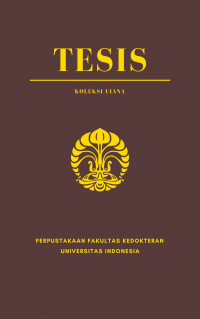Tesis
Prevalence of Lower Urinary Tract Symptoms Post Kidney Tranpslantation and Its Urodynamic Profile.
Background: Kidney transplantation is the main treatment for patients with end-stage renal disease. After undergone kidney transplantation, changes in storage and voiding functions of the lower urinary tract in the first six months post-transplantation of the kidney is still occurring. During this period urinary retention can occur. Objective: This study aimed to determine the prevalence of urinary retention after kidney transplantation and to describe the urodynamic characteristics of post-transplant kidney patients with urinary retention. Method: This research is a cross-sectional study conducted at Cipto Mangunkusumo National General Hospital in 2011-2017. Data are collected from patients undergone urodynamic examination after kidney transplantation. Data are collected from the patient's medical record. Results: A total of 536 patients underwent kidney transplants in RSCM, including 11 patients (2%) urinary dysfunction who underwent urodynamic examination with an average age of 41.4 (30.1 ± 52.6) years including 2 women. Six patients (55%) had type 2 diabetes mellitus (DM) and 5 patients (45%) had hypertension (HT). A total of 6 out of 11 patients (54%) experienced urinary retention, four patients (36%) complained of frequency complaints, and one patient (10%) complained of hesitancy and feeling of incomplete emptying. As many as 50% of patients experienced a decrease in bladder compliance, of which two patients (33%) experienced urine retention with normal bladder compliance. Detrusor overactivity was found in four patients (36%) from total sample and three subjects (50%) among patient with urinary retention. Four patients (36%) experienced bladder outlet obstruction (BOO) and 50% of patients with urine retention experienced BOO. Two patients were diagnosed with detrusor instability which was not accompanied by incontinence. Two patients (44%) had normal bladder contractions. Conclusion: Urinary dysfunction and urinary retention were found in 2% and 1.1% of 536 patients after renal transplantation respectively. Most patients with urinary retention have DM type 2. BOO and detrusor overactivity are found in patients with urinary dysfunction and urinary retention. Routine urodynamic examinations in patients before a kidney transplant are also recommended.
Keywords: urine retention; kidney transplant; urodynamic profile
Latar Belakang: Transplantasi ginjal merupakan tata laksana utama pada pasien dengan end-stage renal disease. Salah satu perubahan pascatransplantasi ginjal adalah adaptasi fungsi penyimpanan (storage) dan pengosongan (voiding) dari traktus urinarius bagian bawah dalam enam bulan pertama pascatransplantasi ginjal dimana retensi urine dapat terjadi. Tujuan: Penelitian ini bertujukan mengetahui prevalensi retensi urine pascatransplantasi ginjal dan untuk mendeskripsikan karakteristik urodinamik pasien pascatransplantasi ginjal dengan retensi urine. Metode: Penelitian ini merupakan penelitian studi potong lintang yang dilaksanakan di RSUPN Dr. Cipto Mangunkusumo pada tahun 2011-2017. Data diambil dari pasien pascatransplantasi ginjal yang dilakukan pemeriksaan urodinamik Data diambil dari rekam medis pasien. Hasil: Sebanyak 536 pasien menjalani transplantasi ginjal di RSCM, di antaranya terdapat 11 pasien (2%) disfungsi berkemih yang menjalani pemeriksaan urodinamik dengan rerata usia 41,4 (30,1±52,6) tahun, dimana dua orang diantaranya adalah perempuan. Enam pasien (55%) memiliki diabetes melitus (DM) tipe 2 dan 5 pasien (45%) memiliki hipertensi (HT). Sebanyak 6 dari 11 pasien (54%) mengalami retensi urine, empat pasien (36%) mengeluhkan keluhan frekuensi, dan satu pasien (10%) mengeluh adanya hesitancy dan perasaan tidak lampias setelah miksi. Sebanyak 50% pasien mengalami penurunan bladder compliance, dimana dua pasien (33%) di antaranya mengalami retnesi urine dengan normal bladder compliance. Overaktivitas detrusor ditemukan pada total empat pasien (36%) dan tiga pasien (50%) pada pasien dengan retensi urine. Sebanyak 4 pasien (36%) mengalami bladder outlet obstruction (BOO) dan 50% pasien dengan retensi urine mengalami BOO. Dua pasien juga didiagnosis mengalami instabilitas detrusor yang mana tidak disertai inkontinensia. Dua pasien (44%) memiliki kontraksi kandung kemih normal. Kesimpulan: Disfungsi berkemih dan retensi urine ditemukan sebanyak 2% dan 1,1% dari 536 pasien pascatransplantasi ginjal. Sebagian besar pasien dengan retensi urine memiliki DM tipe 2. BOO dan overaktivitas detrusor ditemukan pada pasien dengan disfungsi berkemih dan retensi urine. Pemeriksaan rutin urodinamik pada pasien sebelum transplantasi ginjal juga disarankan.
Kata kunci: retensi urin; transplantasi ginjal; profil urodinamik
- Judul Seri
-
-
- Tahun Terbit
-
2020
- Pengarang
-
Putri Iradita Islianti - Nama Orang
Arry Rodjani - Nama Orang
Nur Rasyid - Nama Orang
Harrina Erlianti Rahardjo - Nama Orang - No. Panggil
-
T20367fk
- Penerbit
- Jakarta : Program Pendidikan Dokter Spesialis Urologi., 2020
- Deskripsi Fisik
-
xii, 13 hal; ill; 21 x 30 cm
- Bahasa
-
English
- ISBN/ISSN
-
-
- Klasifikasi
-
NONE
- Edisi
-
-
- Subjek
- Info Detail Spesifik
-
Tanpa Hardcopy
| T20367fk | T20367fk | Perpustakaan FKUI | Tersedia |


Masuk ke area anggota untuk memberikan review tentang koleksi